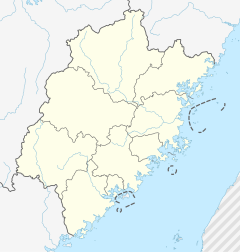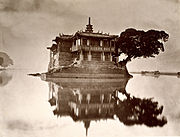| Jinshan Temple | |
|---|---|
| 金山寺 | |
 A frontal view of Jinshan Temple A frontal view of Jinshan Temple | |
| Religion | |
| Affiliation | Buddhism |
| Location | |
| Location | Cangshan District, Fuzhou, Fujian |
| Country | China |
  | |
| Geographic coordinates | 26°04′32″N 119°13′34″E / 26.075694°N 119.226083°E / 26.075694; 119.226083 |
| Architecture | |
| Style | Chinese architecture |
| Date established | Shaoxing period (1131–1162) |
| Completed | 1934 (reconstruction) |
Jinshan Temple (Chinese: 金山寺; pinyin: Jīnshān Sì) is a Buddhist temple located on an island of Wulongjiang River, in Cangshan District of Fuzhou, Fujian, China. It is the only Buddhist temple in the river in China and the only Buddhist temple on the water in Fujian.
History
Song dynasty
The original temple dates back to the Shaoxing period (1131–1162) of the Southern Song dynasty (1127–1279).
Ming dynasty
In the Jiajing era (1522–1566) of the Ming dynasty (1368–1644), Zhang Jing lived here
In 1615, in the reign of Wanli Emperor (1573–1620), the bridge, which connected the island and the bank, was destroyed by flood.
Qing dynasty
In 1870, in the Tongzhi period (1862–1874) of the Qing dynasty (1644–1911), Scottish photographer John Thomson visited the temple and took a lot of pictures, which published in his album Foochow and the River Min.
Modern China
The temple was restored in 1934 after damage by a series of floods.
Architecture
The temple consists of five buildings: Hall of Mazu, Hall of Great Compassion, left wing-room and right wing-room, and a Song dynasty stone pagoda.
Hall of Mazu
The Hall of Mazu is the main hall in the temple enshrining statues of Mazu and Guanyin. Under the eaves is a plaque with the Chinese characters "Jinshan Temple" written by former Venerable Master of the Buddhist Association of China Zhao Puchu.
Stone Pagoda
The seven-story, 10-metre (33 ft) tall, octagonal-based Chinese pagoda is made of brick and stone is situated within the temple.
Gallery
-
 Jinshan Temple in 1871, during the Tongzhi period in the late Qing dynasty (1644–1912), photographed by John Thomson.
Jinshan Temple in 1871, during the Tongzhi period in the late Qing dynasty (1644–1912), photographed by John Thomson.
-
Jinshan Temple in 2015.
-
A stone pagoda at Jinshan Temple.
References
- ^ Zhang Yi (21 April 2018). 5元钱摆渡船才能到达,中国唯一屹立在江中寺庙. Tencent (in Chinese). Archived from the original on 14 May 2018. Retrieved 14 May 2018.
- 老照片:近代海军的摇篮,福建福州1876年. Tencent (in Chinese). 14 April 2018. Archived from the original on 14 May 2018. Retrieved 14 May 2018.
- ^ 水中金山寺的历史“沉浮”. 163.com (in Chinese). 15 May 2012.